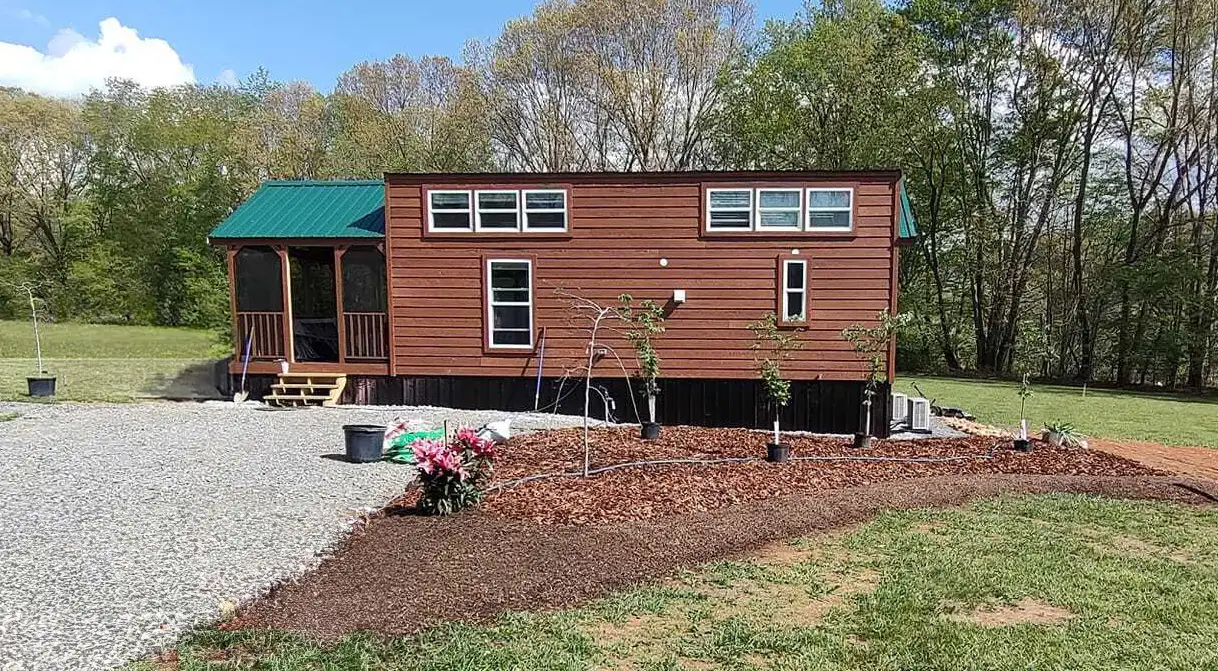These Home Shoppers Kissed The Housing Market Goodbye and Built Tiny Homes Instead

Retiree Billy Poole paid $92,000 for this 560-square-foot tiny home and another $40,000 prepping land a generous neighbor let him use: a football-field-sized portion of a hay field.
Happiness In Unconventional Living
After his divorce a few years ago, retiree Billy Poole had to start over in more ways than one. For his next chapter, he craved a home that blended affordability with minimalist living in nature.
Poole, 62, first got hooked on tiny living a decade ago after watching HGTV shows about it. In 2022, with half of his divorce proceeds in hand, Poole hired a tiny home builder to bring his vision of a simpler life to fruition.
Poole says his 560-square-foot tiny home cost $92,000 to build and deliver. A generous neighbor with extensive land in Damascus, Virginia, offered Poole a flat, football-sized hay field on the property for his tiny home. Poole spent $40,000 or so of his own money to improve the neighbor’s land to make way for his unit and to run septic and electrical.
If you’re interested in living in a tiny home, ADU, RV or other non-traditional style of home, research the local zoning regulations and rules; not all cities allow them while those that do have stringent rules to follow, which may require extra expenses beyond the home and land purchases, Poole points out.
Additionally, Poole says he and his neighbor have a detailed legal agreement in place to protect both of their interests. It spells out what happens to the tiny home and to the land should either party pass away or move for whatever reason.
Like countless other enthusiasts of full-time RVing, tiny living, ADUs and other affordable housing options, Poole doesn’t regret his decision to downsize his space and expenses one bit.
“I'm out in a beautiful hay field at the edge of a beautiful river with mountains all around me,” Poole says. “I’ve got it all. For me, it’s everything I need.”
Finding Affordable Housing For Her Family Was Nearly Impossible
Kathleen O’Steen felt like she was stuck between a rock and a hard place when trying to figure out how to care for her aging mother and her disabled adult daughter with housing costs spiraling out of control.
O’Steen, a registered nurse who lives near Austin, Texas, says she wanted to move her mother and daughter, both two hours away in San Antonio, closer to her.
However, finding an affordable home in her area to accommodate everyone’s needs felt like searching for a needle in a haystack because of limited options, high mortgage rates and Austin’s soaring home prices.
So, O’Steen got creative and found another solution for her family’s housing dilemma: tiny living.
Using proceeds from her home sale the year before, in 2023, O’Steen created what she lovingly calls her family’s “village” of four tiny homes — one each for O’Steen, her mother, her daughter and another for guests.
The tiny homes are nestled on five acres of land in Bastrop County, Texas, near Austin that O’Steen has owned (and has sat vacant) for two decades. At the heart of their U-shaped “tiny village,” a large covered patio with a hot tub acts as a gathering place for family meals and catching up, O’Steen says.
“It turned out beautifully and we’re super happy with it,” says O'Steen, 60, noting that while she fronted most of the up-front costs, her mom took out a small mortgage for her tiny home to help offset some of the expense. O’Steen says she’s also grateful she could help her daughter who’s struggling with health issues and can no longer work.
“The stress when you're ill and disabled of trying to pay your bills, that's been removed for her,” O’Steen says.
In all, between the costs to buy the homes (minus her mom’s $69,000 tiny home mortgage), installing septic and electrical, adding small patios for each home and building the communal space, O’Steen estimates she spent about $123,000 in cash to create their tiny village.
While that may seem like a lot, the median home sales price in Austin hit $586,000 in May 2024, up 3.7% from a year ago, according to Redfin data. On the other hand, a tiny home costs, on average, $30,000 to $70,000 to build, including materials and labor, according to HomeGuide.com, a home services marketplace.
Local zoning regulations and even some lenders may require tiny homes and other non-traditional housing structures to be installed on permanent foundations on a plot of land you own, which are additional costs to consider beyond the price of the home and adding utilities.
For O’Steen’s family, tiny living just made more financial and practical sense.
For starters, she estimates the combined monthly utility bills for all four tiny homes are a third less than the three-bedroom, two-bath home she previously lived in alone. Plus, maintenance costs and upkeep are minimal, there’s less space to clean and three generations of her family are enjoying the benefits of communal living while still having independence and privacy, O’Steen says.
“It was a great financial move, and I’m very proud of what we’ve created,” O’Steen says.
Affordability Woes Drive Push For Alternative Housing
The American dream of homeownership, long extolled as the ultimate wealth-building zenith, is slipping farther out of many people’s reach.
Plagued with sticky inflation and rising living costs, some have abandoned their vision for buying a vanilla single-family home with a white picket fence in the suburbs in favor of more affordable living arrangements. These unconventional options include tiny homes, RVs, accessory dwelling units (ADUs), modular homes, barndominiums and houseboats, among others.
It’s not hard to see why.
Everywhere consumers look, the news headlines tell a similar daunting story of costs going up with no end in sight, including home prices and, to a smaller degree, rents.
The national average rent for a typical one-bedroom apartment is about $1,534 per month, up 0.7% from a year ago, according to July data from Apartments.com.
Home prices, however, are accelerating much faster. In May, U.S. median home prices for all property types hit a record-high $419,300, up 5.8% year over year, according to data from the National Association of Realtors (NAR). It’s also the highest median home price ever recorded.
"Home prices reaching new highs are creating a wider divide between those owning properties and those who wish to be first-time buyers," Lawrence Yun, NAR’s chief economist, said in a statement. "The mortgage payment for a typical home today is more than double that of homes purchased before 2020.”
Higher mortgage rates are adding more salt to the affordability wound. The average 30-year fixed mortgage rate hit 6.89% the week of July 11 and has hovered at or above 7% for much of the year, according to Freddie Mac’s weekly Primary Mortgage Market Survey.
Another wrinkle: housing inventory. For the first five months of 2024, the number of active homes on the market hit the highest level since 2020, according to the latest data from Realtor.com. While this is a step in the right direction, the housing inventory is still down 34.2% compared to pre-pandemic levels, Realtor.com reported.
One of the reasons why more homes haven’t flooded the for-sale market is due to the lock-in effect of rising mortgage rates on current homeowners. These mortgage borrowers bought a home or refinanced during the pandemic when rates hit rock-bottom at 2% to 3%, so they’re understandably reluctant to trade in their low rate and affordable payment for today’s much higher prices and rates.
But, as the two aforementioned homeowners show, you can get creative and come out a winner even in this market.







